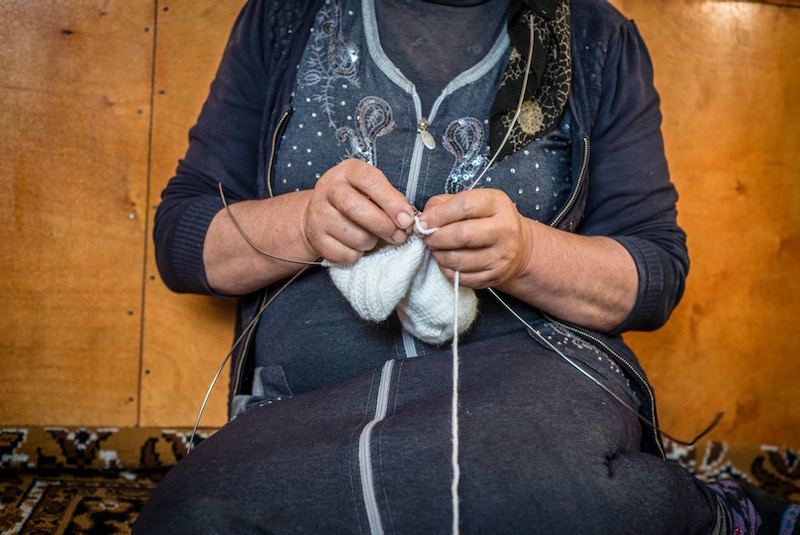There are various domestic metrics by which I keep track of how many of the children are around at any given point: how fast we’re getting through the milk, how many times I have to restock the chocolate in the fridge to make sure there’s a bar there when I want some, and so on.
The amount of washing is another clear indicator, but it’s an interesting one because there’s a lot more subtlety to it than you might think, and also it is affected by so many external factors (the season, often the weather, but also very noticeably social commitments, or work trips up to London). Because of our numbers, a small element can loom large. When five-a-day for fruit and vegetables came in, I was daunted by the thought of having to organise, buy, carry home and cook or prepare forty separate pieces of fruit or servings of vegetables every single day (and potatoes don’t count). Similarly socks for everybody are a significant part of the washload, because everyone needs at least two every day for most of the year, at least this far north.
Someone going for a run doubles their sock through-put; and an evening event that you have to dress up for can mean yet another pair, especially in hot weather. My husband tried wearing neat sandals to one event while we were abroad, and the local press took umbrage, so he could never do it again.
I’ve always liked socks, from the ridiculously tiny ones which you have to keep putting back on a baby’s feet up to the thicker ones for walking, or longer for wearing with a kilt. Their design is so simple and yet so clever. I make socks, and there are lots of different ways to make them more comfortable and hardwearing, different ways to turn or reinforce a heel. You can even knit them on a spiral which means you don’t need to knit the heel as a separate piece of engineering, though I have to admit that a fully-fashioned exactly-fitting sock gives considerable satisfaction both to the knitter and to the recipient. It’s easiest to knit them for someone you see regularly, because you can check the fit as you go and make it exact, but you can do a pretty good job by making your family members stand on a piece of paper and drawing carefully around their feet. (But it does tickle.)
Historically both men and women have been knitters (and God too! See Psalm 138/9.13), but it’s mostly women, and when I knit something as timeless as a sock, I enjoy feeling that I am in a long line of female technicians keeping their family’s feet warm. In many ethnographic museums as well as the V&A, you can see examples of knitted socks of unbelievable age, and the techniques and designs have not changed much. After all, neither have feet. Some of the oldest extant socks have the divided toe that indicates a flip-flop or geta-style shoe, but mostly socks are simple in shape.
Having said that, the best technique to finish and close the toe without leaving a seam which might chafe, is called ‘Kitchener’, and it’s the same Lord Kitchener as ‘Your country needs YOU’, from only the last century. He apparently worked out how to do this particular grafting stitch because so many homemade socks sent to comfort the troops in World War I had toe seams which made them uncomfortable.
I think myself that he probably asked his grandmother, mother or sister, but then managed to publish the technique more widely than had happened before, and that attached his name to it (after all, it might have been their name too). You can pattern socks with different textures or with colour – or even both! – and it’s fun to be creative on a small but perfect scale. It’s the same sort of satisfaction that I find in producing a well-fitting musical setting for a Gospel Acclamation. When you get it right, it works. Knitting socks is rewarding, and they make a very portable project, although it’s harder to keep track of the needles as they are pointed both ends and can disappear amazingly easily (I’m still annoyed about the one I couldn’t retrieve after it slipped down the side of a train seat).
There are old-fashioned sock knitting machines, like those Dutch knitting dollies we had as children, which make an excellent tube for the body of the sock, but I don’t know how you would turn the heel, and the toe is just gathered, which we Kitchener-types regard as less elegant. I imagine they rely on the spiral effect, but the heel won’t be as comfortable. Because socks are mainly out of sight, they are a way to express personal choice without being too obvious, so some people go for the unexpected – even deliberately odd socks, to express the fact that they are a wild non-conformist at heart, even if they do have to wear a shirt and tie or a suit to the office.
You can give people socks in a design which you know they will appreciate, without having to worry that it will expose them to ridicule. My eldest daughter Rachel has a cherished collection of animal socks, so I look out for strange beasts she hasn’t got already, and a subset of different dinosaurs. I wanted to find middle son John some octopus socks, because he knows a lot about octopodes, including their different plural forms; but I thought he wouldn’t wear them, until I discovered that he had bought himself some Star Wars socks, so the hunt for octopus socks is back on again, as any excuse that he can only wear serious socks is already blown. You can even evangelise by sock; after seeing a Tablet advertisement, I tracked down Holy Socks and was so charmed that I am going to get some for the Christmas stockings, which is positively meta. What I hadn’t realised until more recently is that some social analysts or work psychologists are now using socks to make judgments and draw conclusions, not socks themselves, but our relationship with them. Not what you wear, but how you choose them and especially how you store or organise them.
Between them, the children and my husband have been through probably most of the currently-fashionable personnel management tools. Some, like Myers-Briggs, have been around for a long time, so they can compare; some tend to be unusual or possibly personal to a given management consultant. The sock people were a team that my husband encountered. They weren’t asking about what sort of socks people chose to wear, although I think that could be an interesting area. If you choose superhero socks, is it a sign that you are striving for truth, justice and the American way, or does it mean that you harbour secret plans for world domination? Do you choose interesting colours because your life is drab, or drab colours because you don’t want to give anything away? Do you choose interesting colours and then deliberately separate the pairs so as to appear twice as exciting? (Or completely colour-blind.)
The problem with drawing conclusions here is that many people never actually buy their own socks, but are given them by desperate and unimaginative family members, who are choosing for completely different reasons. I do buy socks for quite a few family members, because I can see in the laundry when they get threadbare, and my reasoning is sometimes practical and sometimes aesthetic. It’s easy to share a joke over socks, like Rachel’s dinosaurs; but I choose my husband’s in colours that I know will be easy to pair up.
There was a period when shops were selling sets of socks in graded shades of colour, and those were a nightmare to pair in anything other than direct sunlight, especially my husband’s practical office grey ones. (Now I don’t let him choose, and luckily this was all before several shades of grey became shorthand for something else.) Little designs or motifs on socks (historically and confusingly known as ‘clocks’) are also very helpful when you are sorting socks, but highly irritating when you end up with two perfectly good socks, one with a stormtrooper helmet embroidered on it and one with Darth Vader’s, but the probable owner refuses to check the socks in his own house and also refuses to wear socks that don’t match.
So what socks you wear is not a management diagnostic tool, but how you organise them apparently is. The management consultants divided up the people on the course according to how they stored their socks. Options available were by colour, by type (e.g. office or sports), by weight (cotton or wool), in separate drawers or with other underwear, and so on. My husband gamely joined the group of people (free spirits and creatives, apparently) who organise their socks by keeping them all together in a drawer, but he was thrown out of the group when he admitted that he is not actually the person who puts his socks away. So socks are not necessarily a good tool for management evaluation and discussion. I suspect he may simply have been more honest than some of the others there.
Bishops wear not only puce gloves, as Rupert Brooke noticed with joy, but also puce or magenta socks. Cardinals wear red socks; as a little boy my husband met Cardinal Heenan, who showed him his red socks and told him about why he had to wear them, which was a formative experience he remembers clearly to this day. Popes wear white socks, although presumably they can all wear something different privately or when on holiday. I am so glad that we no longer have to have uniform socks for the children, always the trickiest of garments to label. Socks can be frivolous as well as serious. I am currently knitting a pair of trainer socks for my youngest daughter Margaret, which have a cable lace frill. She chose the colour (dark green). My husband has an orange and black pair made by our middle daughter from a design on a Greek vase. This is partly to send him up, but they are a very handsome pair of socks. Making socks for someone is an act of love. My Ukrainian friend (one of the best craftswomen I know) decided to make a pair of socks for her father out of a raw wool fleece, as a project. She learned how to do each step of the process, first creating the yarn by carding and spinning, and then knitting the socks. What a lovely gift.
Kate Keefe composes musical settings for the Mass and writes about the psalms.



 Loading ...
Loading ...
What do you think?
You can post as a subscriber user ...
User comments (0)